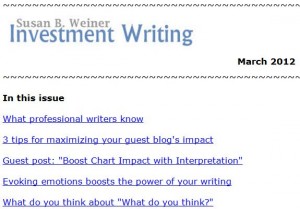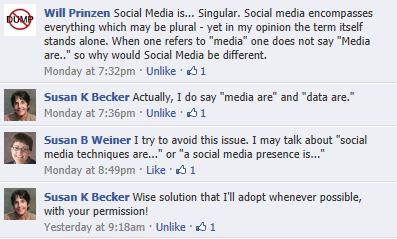The NICSA General Membership Meeting on October 6 addressed challenges facing investment managers and their service providers. Compared to other industry conferences, it emphasizes the “back office” functions that support investment professionals.  In this post I present some of what caught my attention at the conference–mostly information about regulation and marketing.
In this post I present some of what caught my attention at the conference–mostly information about regulation and marketing.
The short statements are tweets, grouped by speaker. I also link to my blog posts on the meeting. In case you’re wondering, #NICSAGMM is the hashtag used on Twitter to help people find tweets related to the conference.
My blog posts about #NICSAGMM
OppenheimerFunds on the separation of marketing and sales
Citi on financial services’ biggest potential social media mistake
Opposing financial services’ social media paralysis at #NICSAGMM
Robert Pozen, MFS Investment Management, on financial reform
The back office makes mutual industry go, says Bob Pozen, MFS #NICSAGMM
Bob Pozen: SRI = systematically risky institutions. Means lots of extra regs #NICSAGMM
Pozen: Cost of SRI bailouts borne by other SRIs, NOT taxpayers #NICSAGMM
Pozen: Proprietary trading will shift from US banks to least regulated countries and companies with Volcker Rule #NICSAGMM
Pozen: Good change with Dodd-Frank: clearing for derivatives #NICSAGMM
Pozen suggests investment advisors form their own SRO #NICSAGMM
Pozen: C shares will be required to convert to A shares eventually #NICSAGMM
Pozen: Fluctuating NAV for money market funds would be end of MMFs for retail investors #NICSAGMM
Pozen: Hope we don’t over-regulate MMFs. Only 2 broke the buck #NICSAGMM
Pozen: Public-private firms like T Rowe, Franklin, Legg Mason, Black Rock will be winners in asset mgt #NICSAGMM
Pozen: Public-private means some public stock, but strong internal mgt control #NICSAGMM
Pozen: Restricted shares shouldn’t vest just because you’re still alive. Tie to performance. #NICSAGMM
Pozen: “Mortgages are the big banana that has never been touched.” Barely touched by Dodd-Frank #NICSAGMM
Pozen: Qualified residential mortgages (QRMs) will be important. Downpayment requirement will be key. #NICSAGMM
Bob Pozen: Europe has solvency crisis, US doesn’t have one…yet #NICSAGMM
Pozen: Repeated budget crises -> instability. Need to bring back compromise. #NICSAGMM
Pozen: Another crisis is inevitable at end of 2012 when Bush tax cuts expire & budget is issue #NICSAGMM
Pozen: Customers want best products at best price. #NICSAGMM
Pozen: People don’t understand inverse relationship between interest rates and bond prices #NICSAGMM
Marty Willis, OppenheimerFunds
Marty Willis, Oppenheimer Funds: Mutual funds’ biggest challenge = lack of differentiation. #NICSAGMM
Willis: New tech will allow wholesalers to improve the value they offer. Like pharmaceutical reps. #NICSAGMM
M. Willis, Oppenheimer Funds: Marketers’ toolkit now more complete. #NICSAGMM
M. Willis: Fund marketing has become editor of content across web, print, social media. #NICSAGMM
OppenheimerFunds is using predictive modeling to help wholesalers decide who to call on. #NICSAGMM
Peter Thatch, Merrill Lynch Global Wealth Management
Peter Thatch, Merrill Lynch Global Wealth Management: “Clients’ risk appetite has fallen off the cliff.” #NICSAGMM
Thatch: Products that meet clients’ current needs are more complicated #NICSAGMM
P Thatch: You’ll see more global TAA with risk parameters. #NICSAGMM
Joseph D. Kringdon, Pioneer Funds Distributors/Pioneer Investments
J. Kringdon, Pioneer Funds Distributors: If you died tomorrow, what would your clients miss about you? That’s your value. #NICSAGMM
J. Kringdon, Pioneer Funds Distributors: Clients don’t care about benchmarks #NICSAGMM
Kringdon: Pioneer Investments tries to build its intellectual capital & deliver in multiple media #NICSAGMM
Visit multisectorbond.com to see creative site for advisors to back-test fund #NICSAGMM
Lee Kowarski, kasina
L Kowarski of @kasinaUS: Compensation is broken, but no one wants to lose wholesalers. #NICSAGMM
Penny Alexander, Franklin Templeton Investments
Penny Alexander, Franklin Templeton: Best biz growth opportunities for fund cos = non-US #NICSAGMM
P Alexander: Most developed countries aren’t breeding any more. #NICSAGMM
P Alexander: $10/month invested by world’s middle income earners−>$391 billion in annual gross sales. #NICSAGMM
P Alexander: Need scale to manage lots of small accounts #NICSAGMM
Cartoon: “If we take a late retirement and an early death, we’ll just squeak by.” #NICSAGMM
P Alexander: 3-legged stool for retirement isn’t enough #NICSAGMM
P Alexander: Retirement now needs a kaleidoscope with lots of little pieces. #NICSAGMM
P Alexander: Fund industry can affect mindset & behavior to meet retirement challenge. #NICSAGMM
Penny Alexander: Technology is key to reaching next generation of investors. #NICSAGMM
P Alexander: Muslim investors don’t get as much attention as they should. #NICSAGMM
 list to receive it. When you subscribe, you’ll receive a free copy of Investment Writing Top Tips, an annual compilation of my best tips for marketing, writing, and more.
list to receive it. When you subscribe, you’ll receive a free copy of Investment Writing Top Tips, an annual compilation of my best tips for marketing, writing, and more.










